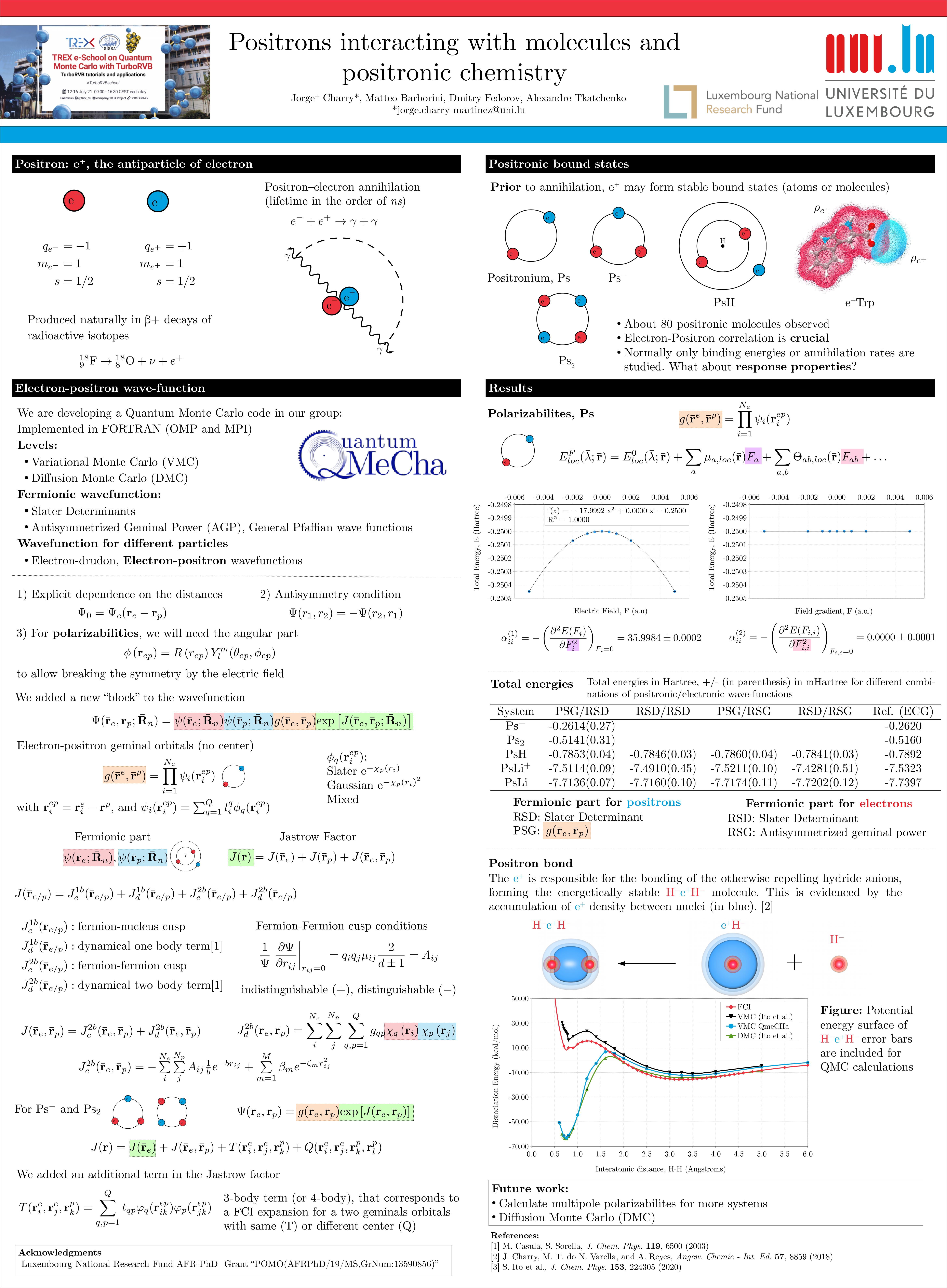This page shows the various Posters submitted during the TREX e-School on Quantum Monte Carlo with TurboRVB 2021.
Best Poster: The best poster of the TREX e-School on Quantum Monte Carlo with TurboRVB Poster Competition 2021 is the number #4 Positrons interacting with molecules and positronic chemistry by Jorge Charry Martínez, Matteo Barborini, Dmitry Fedorov, Alexandre Tkatchenkoa, Université du Luxembourg.
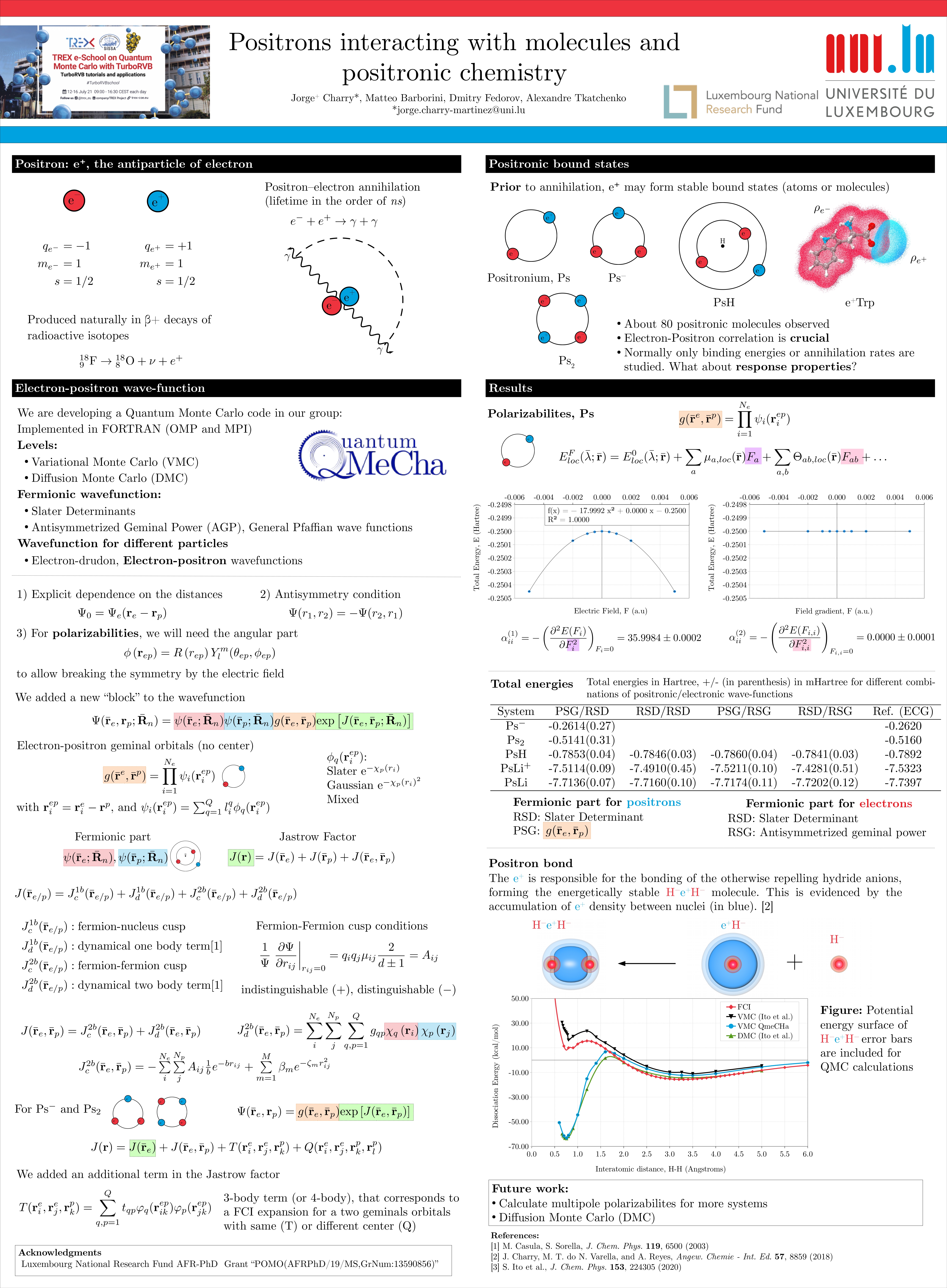
See the rest of the entries below:
- 1. Theoretical investigation of the molecular structure, vibrational spectra, thermodynamic and nonlinear optical properties of 4, 5‐dibromo‐2, 7dinitro‐ fluorescein
-
In this article, we have investigated the structural analysis, thermodynamics, non-linear properties and vibrational analysis of 4′,5′-dibromo-2′,7′-dinitro-3′,6′-dihydroxyspiro[isobenzofuran-1(3H),9′-[9H]xanthan]-3-one. We used the restricted Hartree–Fock and density functional theory (PBE1PBE, MPW1PW91, B3PW91 and B3LYP) approach to calculate the optimized parameters such as; dipole moment, average polarizability, anisotropic polarizability, first-order molecular hyperpolarizability, electric susceptibility, linear refractive index, dielectric constant, energy band gap, Zero-point vibrational energy, total electronic energy, Gibbs free energy, Enthalpy, molar heat capacity at constant volume and Entropy with a cc-pVDZ basis set. In addition, we also computed IR and Raman spectra. Our results show that this molecule has potential applications as a linear and nonlinear optical material. Due to the large first-order molecular hyperpolarizability of this molecule, we think that the molecule eosin B has potential applications in the field of optoelectronics. This can be a promising material for optical applications.
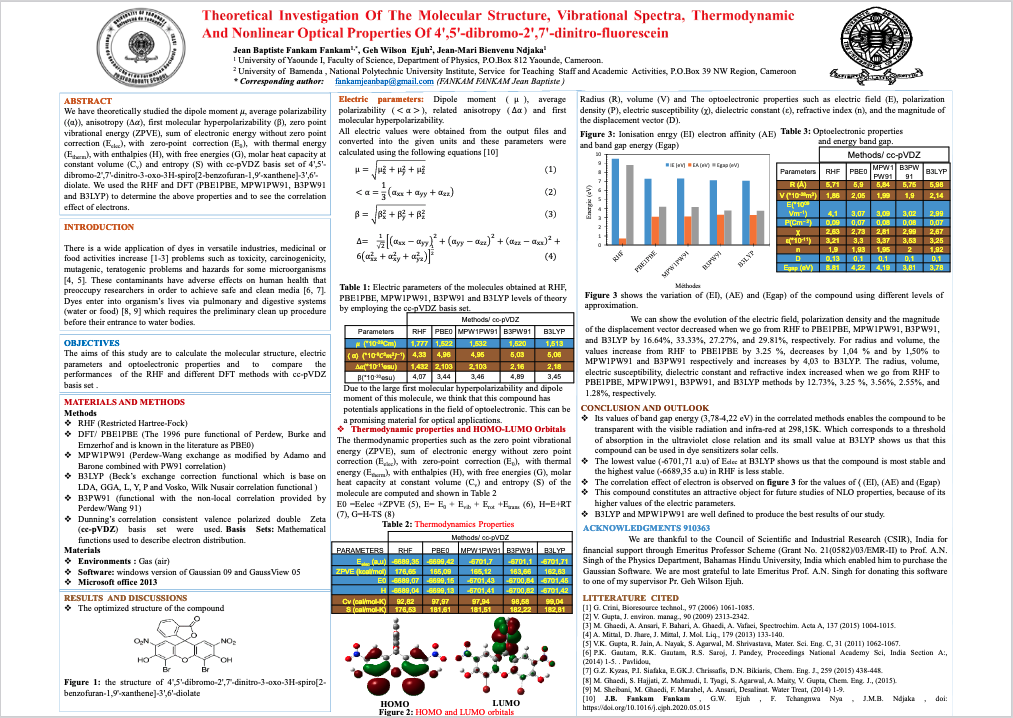
- 2. Tunneling anisotropic magnetoresistance of Pb and Bi adatoms and dimers on Mn/W(110)
-
Noncollinear magnetic structures at transition-metal interfaces are very promising candidates for spintronics applications [1]. An Mn monolayer on W(110) is a prominent example that exhibits a noncollinear cycloidal spin-spiral ground state with an angle of about 173 degrees between neighboring spins. This allows rotating the spin-quantization axis of an adatom or dimer quasi continuously and is ideally suited to explore the angular dependence of the tunneling anisotropic magnetoresistance (TAMR) using scanning tunneling microscopy. Here [2], using density functional theory, we explored the TAMR effect of Pb and Bi adatoms and dimers adsorbed on this surface as these elements have a very strong spin-orbit coupling. Pb and Bi adatoms and dimers show a large TAMR up to 60% due to strong spin-orbit coupling (SOC) and the hybridization of 6p orbitals with 3d states of the magnetic layer. For dimers, the TAMR also depends sensitively on the dimer orientation with respect to the crystallographic directions of the surface due to bonds formation with the surface and the symmetry of the SOC
induced mixing.
[1] A. Fert et al. Nat. Nanotechnol. 8, 152 (2013).
[2] S. Haldar et al. Phys. Rev. B 100, 094412 (2019)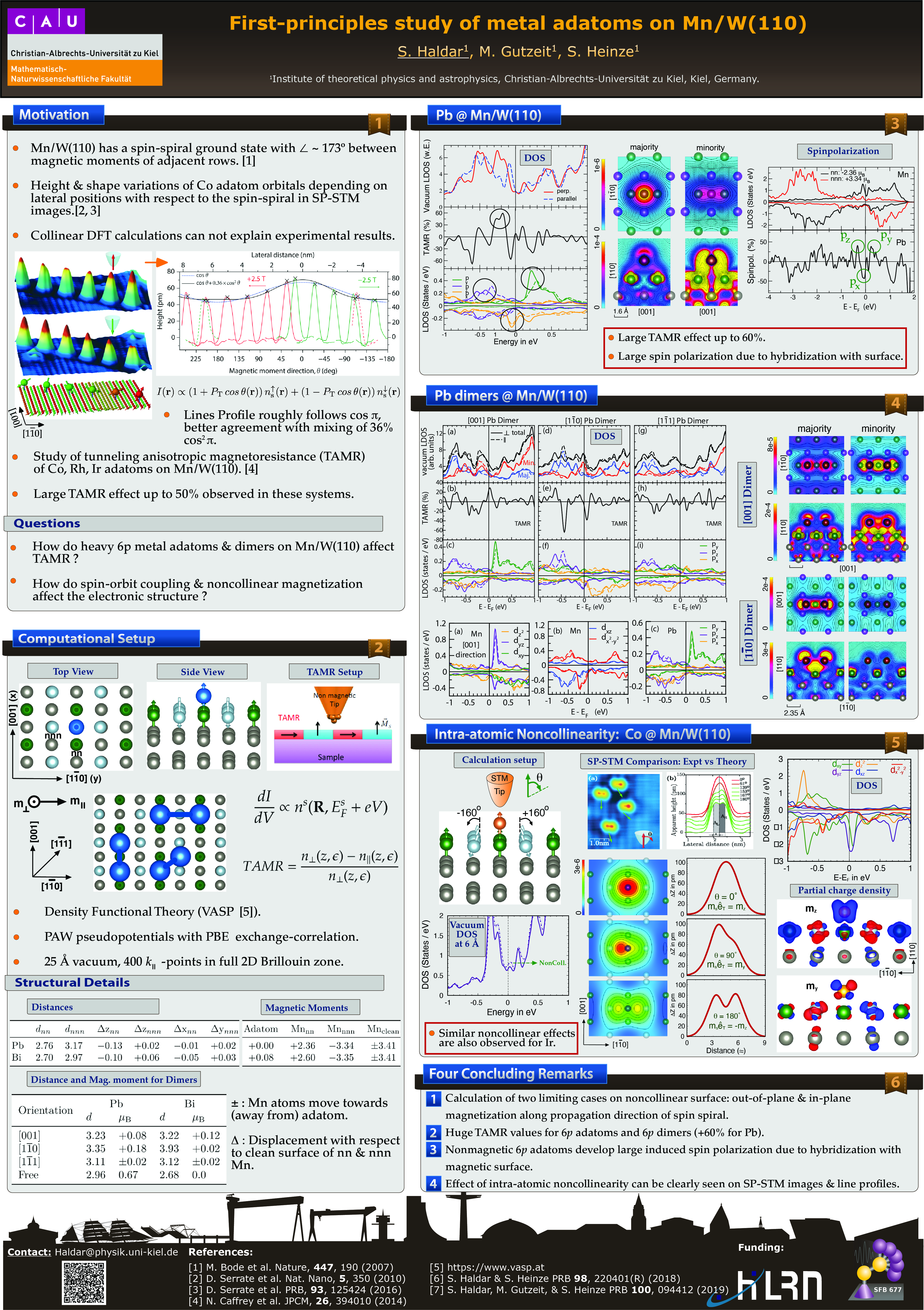
- 3. A Stable Triplet State in Small Polyaromatic Hydrocarbons by in Silico and Model Study
-
The primary aim of our research is to study molecular phenomena with the help of electronic structure theory and also to develop some computationally affordable methods. Singlet-triplet (ST) gap study is an extremely important parameter in the context of singlet fission phenomena, radicaloid formation, organic electronics and spintronics etc. Combining the roles of spin frustration and geometry of odd and even numbered rings in polyaromatic hydrocarbons (PAHs), our proposed fused acene-azulene molecules are shown to have lowest ST gap among isomeric polyazulenes and polyacenes. Based on this study we have proposed a designing principal to build such molecules.
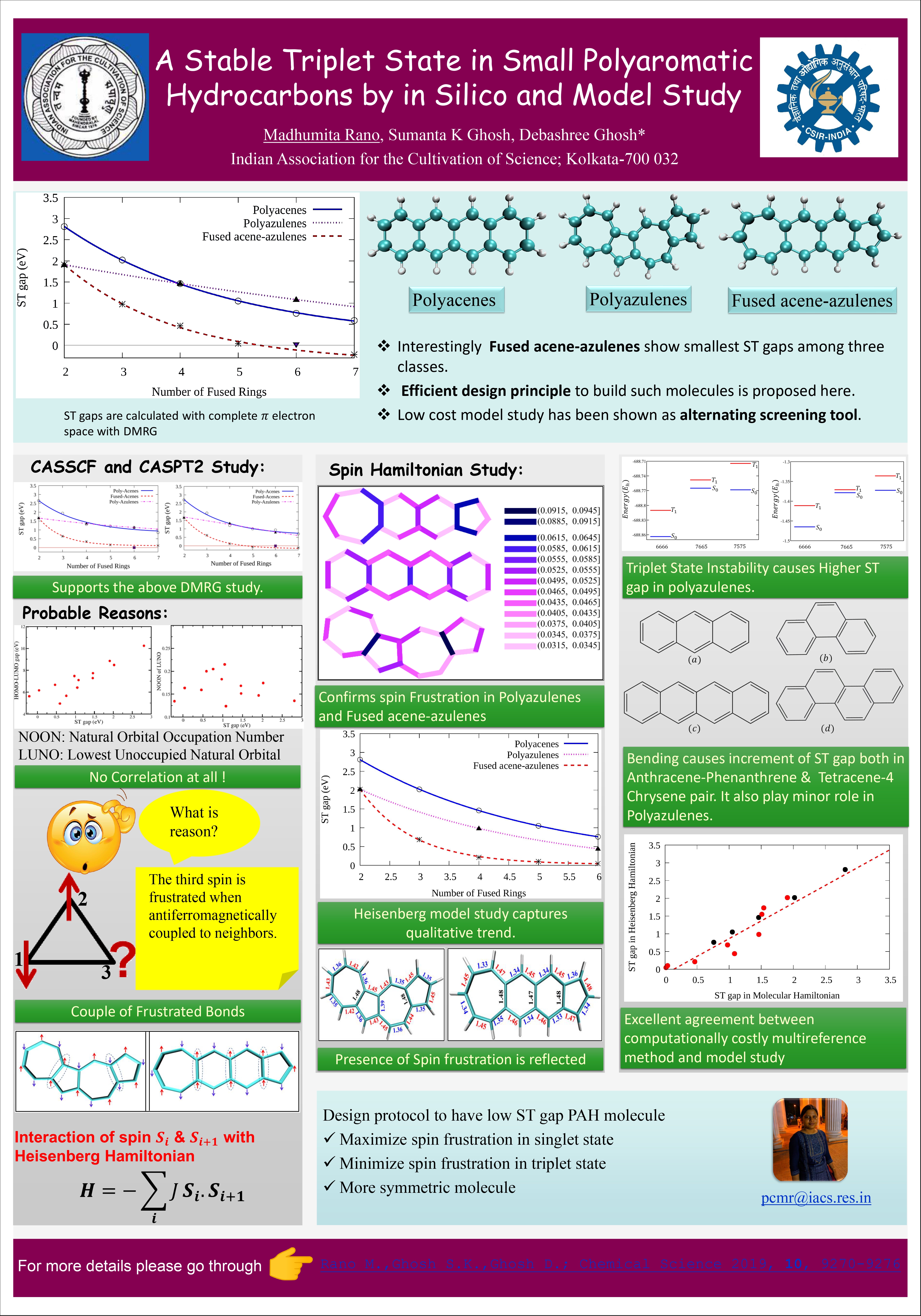
- 4. Positrons interacting with molecules and positronic chemistry
-
Positron is very useful in many applications based on the electron-positron annihilation, but besides that process, positron may form metastable states with atomic and molecular systems [1]. The description of the positron-electron correlations in these systems is still a challenge for quantum chemistry methods, even more the study of response properties, such as the polarizabilities, which is crucial to understand the interactions with other charged or neutral species.
In this work, we apply Quantum Monte Carlo methods to consider an ansatz that includes a set of electron-positron geminal orbitals to explicitly account for the interparticle correlation. This is currently implemented in our QMC Fortran code called QmeCha. Through this novel approach, we present first calculations on total energies, and polarizabilites for a set of positronic atoms and molecules, comparing them with other quantum Chemistry methods.
[1] G. F. Gribakin, et al., Rev. Mod. Phys 82, 2557 (2010)